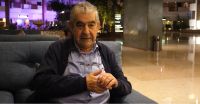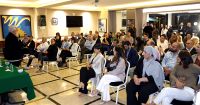Somewhere between stepping off the school bus and climbing into the go-kart, Sandra Ibrahim, 14, took off her pink hijab. She was on a trip to an indoor amusement park in New Rochelle, N.Y., with her Islamic weekend school, surrounded by other Muslim children, parents and teachers. She knew the adults would like her to keep the head scarf on. But there she was, zooming along the track, her dark brown ponytail swinging freely behind her.
Sandra wants to wear the hijab when she is ready, because she wants to follow the guidelines of her religion. She thought she was ready in fifth grade, when her parents rewarded her with a Barbie video game and other prizes for each week she kept it on. But there was teasing and bullying, her family said. Students at her public school yanked it from her head at least twice. So she took it off. She tried again in the middle of sixth grade, and again in seventh. This year, in eighth grade, she had not even tried.
Sandra lives in a religiously tolerant place, by almost any standard. New York is a cosmopolitan city, and her family’s home is in a heavily Arab enclave in Astoria, Queens, just a block away from the fragrant sweet shops, Middle Eastern restaurants and hookah cafes along Steinway Street. On Wednesday, Mayor Bill de Blasio announced that New York would become the nation’s largest city to close public schools for the two most important Muslim holidays, Eid al-Fitr and Eid al-Adha, a move that officials hope will help increase tolerance in the schools. Still, Sandra’s life as a young Muslim has not been smooth.
It is much the same for many of the dozens of young teenagers with whom she attends Islamic school each weekend at the Muslim American Society community center, on the top floor of a three-story office building on Steinway Street. Most of the children, like Sandra, attend public school during the week, and live in two worlds. The broader American culture confronts them with a drumbeat of news about Islamist terrorism, movies like “American Sniper” that depict Muslims as enemies, and video games in which the villains have beards and turbans. Then there are their families and religious institutions, where the Islam they learn, they say, stresses personal responsibility, being good and turning the other cheek. It is a religion that encourages praying, resisting temptations like gambling or having a girlfriend or boyfriend, and respecting family.
The teenagers at the center said they want people to know they are normal Americans who happen to be Muslim. “When people get to know us, they come to realize that we are just like regular people,” said Saad Shuaib, 15, who attends the Academy of American Studies, a public high school in Astoria. “They see we live our normal lives just like them. It’s just that instead of going to church or a synagogue, we go to a mosque.”
But public school, especially middle school, can be a testing ground. Ahmed Jamil, president of the community center, said he was surprised to hear, during a recent discussion about the dangers of ISIS, how often the teenage boys there said they had been teased and bullied by other children at school. About 10 percent of the students who attend public school in New York are Muslim. “They say, ‘Your father is ISIS, are you ISIS?’ ” Mr. Jamil said of the taunts the Muslim boys had described.
“The kids have a good relationship with their classmates, but if the classmates dislike you for whatever reason, and then you look Muslim or your name is Ziad or Mohammed, it’s easy for them to accuse you,” he added. “And I am surprised those middle school kids are saying the word itself — ‘You are a terrorist.’ ”
Some students can take the comments as a joke. Youssef ElGhandour, 16, said a public school classmate had told him, “You are probably going to bomb up the school.”
“I just say to myself, it’s not true,” he said. “I just brush it off like I never heard it.”
But Sandra, a firecracker of a young lady, could not do that. When others made comments to her, her anger would flare. She would go to the bathroom, lock herself in a stall and cry. Or she would fight back. Once, she pinned a boy’s arm behind his back on the bus when he cursed her out.
“It’s not like I don’t have feelings,” she said. “I have feelings and I’m extremely sensitive.”
By seventh grade, she had become a frequent visitor to the dean’s office, either to report being bullied or because she was in trouble herself. Things were getting out of hand. So she postponed wearing the hijab again, and renewed her focus on her family’s other way of beating such stress. She would become a champion in karate.
Sandra was born in January 2001, exactly eight months before the Sept. 11 attacks. Her mother, Wesam Hussein, 41, quit her job as an assistant bank manager to stay home to raise her and her brother, Mostafa, who is now 11.
Ms. Hussein and her husband, Hossam Tawfik Ibrahim, 45, met at a Cairo karate studio where he was an instructor and she was a student. Mr. Ibrahim was a world champion in karate who competed for the Egyptian national team. He joined the American national team after the couple immigrated to America in 1995 in search of adventure and a new life.
The couple embraced American culture alongside their Muslim and Egyptian traditions, and they speak excellent English. But they are also religious, praying five times a day. When Ms. Hussein decided to start covering her hair in 2004, she immediately noticed a difference in how she was treated, she said.
Clerks at the Motor Vehicles Department would raise their voices to ask her questions, assuming she did not speak English. She began to be harassed on the street. And after the Charlie Hebdo attacks in January, things seemed to get worse. On a street near Chinatown in Manhattan, “seven out of 10 people cursed at me walking by,” she said.
When it came to their children, the couple tried to get the balance between Islamic and secular education right. At first they sent Sandra to a private Muslim school in Astoria. But they pulled her out by the third grade, upset that she could read English only at a first-grade level. She would have to learn to function in the broader world, they decided.
“Even though we are Egyptian and Muslim, she is American first,” Ms. Hussein said. “You can’t decide to live in a country and close your mind and say O.K., I am living only in my own world. You have to, as they do in the stores, mix and match.”
So they sent her to a public school in Astoria, and for the fifth grade, put her on a school bus to Louis Armstrong Middle School in East Elmhurst, Queens, a bustling institution of some 1,700 students that prides itself on mirroring the borough’s diversity. Racially balanced because of a court order that created it in 1979 to ease neighborhood overcrowding, the school is 14 percent Asian, 13 percent black, 45 percent Hispanic and 26 percent white.
But there are not many Muslim girls at Louis Armstrong who wear the hijab — perhaps 20 in all, Muslim students at the school said. In the middle of fifth grade, after Sandra started to cover her hair “because I thought it would be fun, to imitate my mother,” she was bullied.
“People started saying things like: ‘You are not one of us. Why would you do that now? You were supposed to do this later,’ ” Or like, ‘Are you even ready for it?’ It was just really rude,” Sandra said.
Comments came on the bus, in the hallways, sometimes from people she thought were friends, she said. There were curses and mean remarks. She would get angry and retreat to the bathroom, because her mother had said it would look weak to cry in public. But her anger seemed only to intensify the bad treatment. Over time, Sandra became more volatile, getting in fights and arguments, often about things that were not explicitly Muslim.
Other Muslims at the school were not having the same trouble. “I’m wearing it right now and nobody even asks me a question about why I am wearing it,” said Salma Rashwan, 14, who began to wear the hijab in eighth grade. “I have a lot of friends who are Muslim and they don’t get bothered at all,” she added.
“She’s, like, easy to get to,” Sandra’s friend Basmala Mahmoud said. “That’s why people make fun of her.”
Sandra began to remove her head scarf, sometimes without telling her parents, wearing it on the bus but then putting it in her bag at school. “I was insecure for about one to two years, completely,” she said. “And I didn’t know how to control any of it.” The most humiliating point came in seventh grade, she said, when a fifth-grade girl pulled off Sandra’s head scarf by yanking it from the back. Her mother wrote a letter to the principal.
Sandra and her parents believe in the traditional Muslim practice that girls after puberty should cover themselves for modesty. But they sat down to speak about the reality of standing out.
Her parents agreed that for the rest of seventh grade, she need not wear the hijab. “I don’t want her to always feel that she was an outsider,” her mother said. “The bullying was getting a little bit out of hand, and I didn’t want her to get harmed. And she would still have time to wear it.”
Helen Ponella, who started as principal of Louis Armstrong in February, would not comment on Sandra’s situation specifically, but said in a statement, “Creating a school environment where students feel physically and emotionally safe is our top priority and we do not tolerate bullying.”
A few months ago, Sandra returned to daily karate training at the Shotojuku Dojo on Steinway Street, where the walls are covered with golden plaques and a mosaic of karate competition photos. She was in kindergarten when she began training there, but she left in the third grade to train privately with her father and to try other sports. Last year, Mr. Ibrahim, an accountant, took a break from teaching karate. So Sandra, by then a brown belt, returned to the dojo to focus on trying to make it to regional competitions and beyond.
“Seek perfection of character,” she chants with the other students every evening at practice, reciting the dojo’s creed. “Endeavor. Respect others. Refrain from violent behavior.”
Though the studio is only a 15-minute walk from home, Sandra’s mother drives her and her brother there each night in the family’s Mercury Mountaineer. They sing along to country music, Ms. Hussein’s favorite, shouting the singer Luke Bryan’s lyrics about catfish and honky-tonks.
One night in February, Sandra’s face furrowed in concentration as she practiced her kata, the elaborate set of movements that serve as the piggy bank for the kicks, punches and blocks used in karate.
She took her spot on the olive-green mats and repeated the movements: extend right arm, shift weight left, kick with right foot. Extend left arm, shift weight right, kick with left. “Shorten your stance, it’s too long, bring it in,” Kai Leung, who runs the dojo, told Sandra, striding across the floor. “Not so high,” he said of her hands.
On Tuesdays there is sparring. Sandra likes to choose Destiny Vergara, a 12-year-old national champion, as her partner.
On a recent visit, Destiny’s punches were smooth and swift, her movements precise. Sandra, with her slight, angular frame, occasionally wobbled on her feet, pausing to push up her magenta-framed glasses. When she made mistakes, she shook her head in frustration.
Her brother teases that she flinches too much, and her mother said her bravado seemed a bit diminished these days. “She was tougher than this when she was younger,” Ms. Hussein said from the sidelines. “The boys in the class used to be afraid of her. But then growing, you know, she turned a little bit girly.”
The instructor that night, Eddie Nieto, disagreed. “She is a fighter, very aggressive, very determined,” he said.
Karate, Ms. Hussein often tells her daughter, is not about violence, but about self-confidence. “It teaches you to control your temper, to know what to do, to know how to defend yourself without harming the one in front of you,” Ms. Hussein said one recent night at the family’s apartment.
On that front, Sandra felt she was making progress. “I have quite the temper,” she said, sitting on an oversize brown couch across from her mother. “And now I know how to control it.”
“Sort of,” she added.
At school, things seemed to be getting better this year, Sandra said. Many children thought she was Latina when they met her without the head scarf, because of her dark hair and dark, almond-shaped eyes. She had found an eclectic group of friends who accepted her, she said, “and now that I’ve found my place to blend in, I’m trying to break the habit of just trying to blend in with everyone.”
Other girls she knows from Islamic weekend school have had an easier time.
Salma Serour, 13, attends the Women’s Leadership School of Astoria, an all-girls public school popular with the parents of Islamic girls. “There was some teasing, but it was friendly,” she said of the reaction when she started covering her hair. “They called me Humpty Dumpty, but I thought it was pretty funny too.” She has a round face and smiles often.
But Nayerra Zahran, 14, said some students had tried to pull off her head scarf at her middle school, Our World Neighborhood Charter School, where she was the only girl wearing one. “They said, ‘Muslims, you stink,’ ” she said. “They sprayed Axe, perfume and everything. They used to say, ‘Oh, are you Bin Laden’s daughter?’ And it really didn’t make any sense.”
At Louis Armstrong, Sandra found comfort with her new friends, who were Jewish, Catholic, Spanish, black and Muslim. She was making progress at picturing getting back at people who bothered her without actually doing it. “I just imagine their reaction, satisfy myself off of it, and then attempt to control my temper by walking back and forth and holding my hands at my side,” she said.
But it was not to be. On Monday, Sandra’s parents pulled her out of Louis Armstrong; she started at a new middle school, Intermediate School 10 in Astoria, on Tuesday. The last straw came the previous week when, Sandra said, a group of four boys lit a cigarette in the back of one of her classes. They spotted her staring at them, and her mother became worried that they would retaliate if the incident were reported.
“Her safety is my main concern at this point,” Ms. Hussein said.
The new school is just 10 minutes’ walk from her apartment and has many more Muslim students. Sandra had a good first day. “Everybody’s been so friendly to me, and so nice,” she said. “I guess it’s just because I’m new.”
She doesn’t plan to put the veil back on yet, but she thinks she will know when she is ready.
Being a Muslim teenager in New York, she said in the weeks before her transfer, “can be hard sometimes.”
“But you have to remember, you have to fight through it,” she said, “and you have to live your own life, not other people’s lives. You have to live what you want yourself to be.”
![]()
Source: The New York Times





